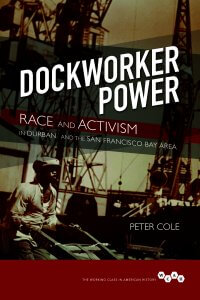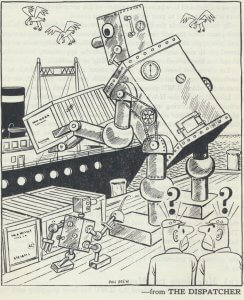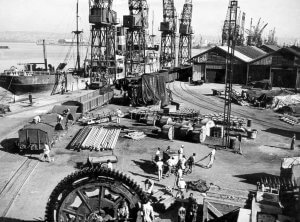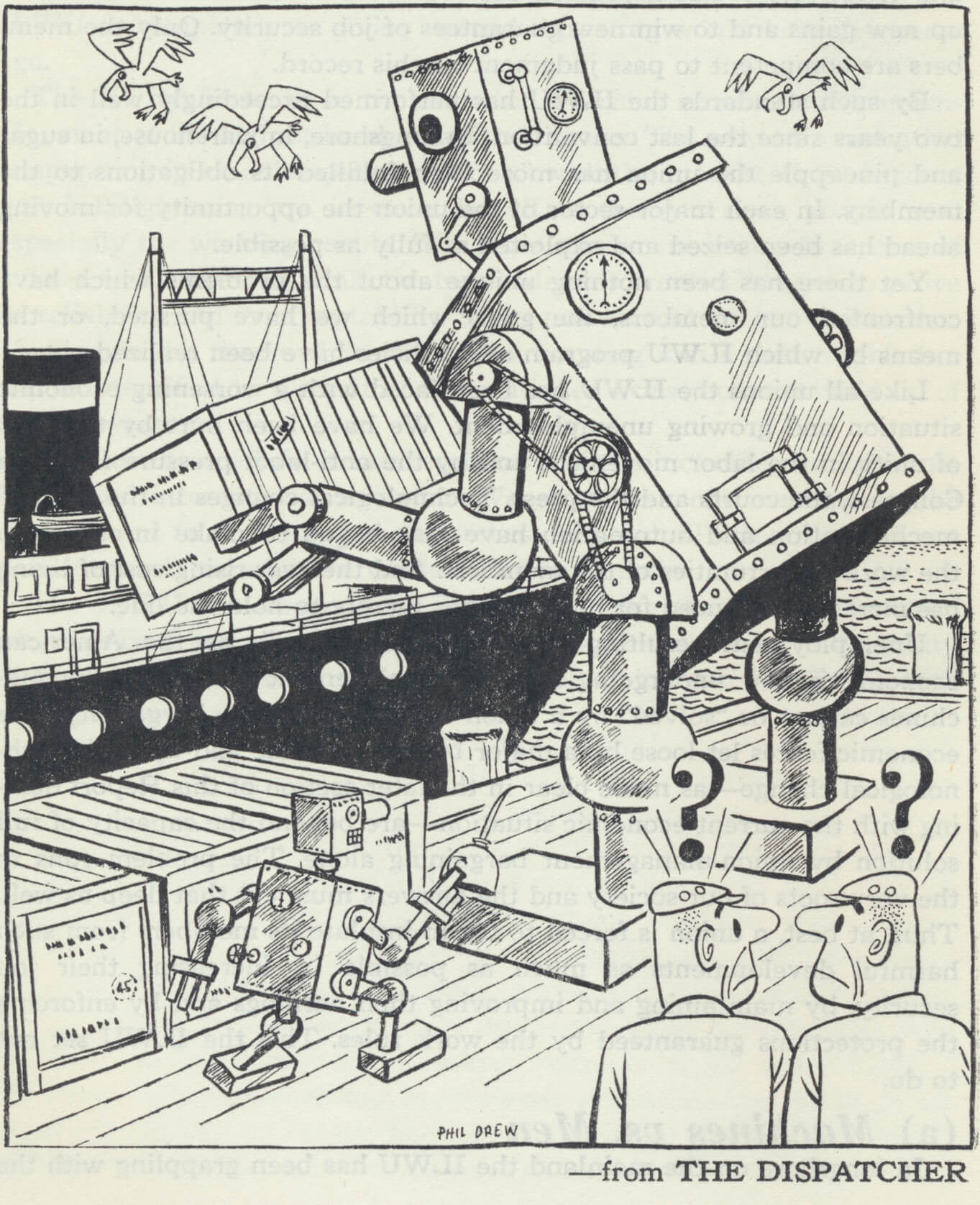Our series on new books in labor and working-class history continues. The University of Illinois Press published Peter Cole’s second book, Dockworker Power: Race and Activism in Durban and the San Francisco Bay Area, in December. Cole, a professor of history at Western Illinois University, answered questions from Jacob Remes.
How did a historian of the United States end up writing a book about Durban, South Africa?
I know it seems random but never as random until you asked me this question! Well, first of all, the world is rapidly changing—it’s become smaller, metaphorically, due to the growing ease of global travel and information exchange. Ever-more of us are connected to people far beyond our home cities and countries. But we also know that academics, historians in particular, can be slow to adapt. I believed it important, as a historian and human being, to become more international. I figured the best way was to push myself—for my second book project—to go beyond the United States, literally. In 2007, I had the incredible opportunity to teach U.S. History at the University of Dar es Salaam in Tanzania. Though not actually close by, I made it a point to visit South Africa, too, because . . . apartheid. More precisely, the struggle against apartheid. As someone interested in social movements, for scholarly as well as political reasons, I was fascinated by the anti-apartheid movement as many of us are. I refer to it as the greatest global social movement of the post-WWII era. Two weeks of meeting people in and traveling throughout South Africa got me hooked. It took a few more years to figure out what I might be able to contribute, that is to the understanding of South African history. I already was deeply interested in the history of San Francisco longshore workers thanks to Bruce Nelson’s Workers on the Waterfront and Howard Kimeldorf’s Reds or Rackets? But became that much more so after meeting a few old-timers in ILWU Local 10. I came to appreciate that dockers in Durban and San Francisco, both great port cities, were perhaps the most militant and important group of workers in their respective communities. Suddenly, I’m exploring archives in Durban, Johannesburg, and Pretoria, teaching seminars on comparative history at Western Illinois University, and more. I consider myself incredibly lucky to have written a book about Durban!

Do port workers—who work in famously diverse and multinational environments—lend themselves especially well to a transnational and comparative approach?
Yes, indeed. Of course, you and I are hardly the first to figure that out. There’s a rich tradition among port workers, as you say, as well as sailors, to live cosmopolitan lives; so, too, historians and others have written a good deal about maritime workers. Yet too often, the term cosmopolitan is reserved for the middle- and upper-classes when, truly, dockworkers have most of those rich folks beat. On a daily basis, longshore workers interact with people who’ve sailed the seven seas. We cannot begin to understand maritime workers and the shipping industry, however, if we straightjacket ourselves by framing their lives inside a single nation. I should note that I’m as guilty as the next historian in trying to do so. My first book, Wobblies on the Waterfront: Interracial Unionism in Progressive-Era Philadelphia, largely explored dockworkers in the context of US history. It took me writing a second book on dockworkers to more seriously consider transnational issues. Comparative methods are a separate and different, if related, beast. I’m proud to say that mine might be the first book comparing the labor histories of South Africa and the United States. I think it’s also the first comparative docker study using ports in the Global North and South. Basically, comparative scholarship is hard to do for the obvious reasons—time, money, languages, tackling multiple different countries’ scholarly traditions, and so on! Now that I’ve written a book of comparative history, I’m shocked more don’t, except for the last point I made. Yet, ultimately, how can one know if one’s conclusions can be generalized by using a case study approach, right? Although my book involves both comparative and transnational methods, I see the latter continuing to expand in influence and popularity among scholars; there simply are too many fascinating and important stories that cannot be properly examined if committed to methodological nationalism. However, comparative methods—quite common, even the norm, in many social sciences—I don’t see a growing trend for that, at least not among historians of the United States. We’re still trapped in the box of nationalism, of American exceptionalism.
It’s hard to imagine an industry that changed so much so quickly from a technological transformation as stevedoring changed from containerization. What does the response of port workers in San Francisco and Durban to containerization teach us about how workers have or can respond to massive technological disruption?

Well, I fully agree that containerization was a revolutionary change—and I don’t use the term “revolution” lightly. Far too many people think about email, Facebook, Whatsapp, and the internet when they talk about globalization. Containers, however, resulted in an expansion of global trade by orders of magnitude. Simply put, the last fifty to sixty years of world history would look very different had there not been an explosion in global trade. Of course, trade agreements and corporate decisions to move production also were crucial but the mass migration of manufacturing from North America and Europe to Africa, Asia, and Latin America simply couldn’t have happened without containers. As to what the specific histories of Bay Area and Durban dockers have to offer, I’d say that there are few more pressing issues for workers than technological change. While some (labor) historians have examined technology, many don’t and fewer of us study workforces on both sides of automation, as in before and after it hits. Among dockworkers, my study clearly demonstrates that strong unions enormously benefit workers. Anyone who doesn’t think so needs to reconsider their beliefs. In San Francisco and across the US West Coast, not a single worker was fired due to containers. Such generally is not the case in other industries when a new technology is introduced—be they blue-, pink-, or white-collar workers. Why? Powerful, multinational shipping corporations had no choice but to negotiate this transition with a powerful, militant union. In Durban, however, employers simply retrenched (fired) half the workers because they were weaker though apartheid also was a major factor as to why. That said, over time, the total number of dockworkers plummeted in the Bay Area as in every other port worldwide. In the Bay Area, there’s fewer than 20% of the longshore workers than before containers. They’re paid quite well and that cannot be ignored. But they’re paid really well because they still have a strong union. By contrast, most workers in the transportation industry—across the longer supply chain—earn a fraction what union dockworkers do, who also have quite good health and pension benefits, and a raft of other perks. Yet, today, even these dockworkers are at great risk. My take has become, technology is neither pro- or anti-worker. Rather, who controls it and the way it’s implemented, those are the keys. I should also note that Harry Bridges, who negotiated the shift to containers for US West Coast longshoremen, often emphasized that dock work became easier and safer which is nothing to sneeze at, right? Of course, if one doesn’t have a job . . . If technology-driven precariousness isn’t the greatest issue of 21st century workers, worldwide, I don’t know what else is. Those of us who study labor need to be thinking much more about these sorts of histories. I started my book focused upon how organized dockworkers were the leaders of the civil rights and anti-apartheid movements in their cities—and they were, which is both fascinating and largely unknown. But the tech stuff, well a third of my book ended up being about containers because it’s such a vital issue, then and now.
What do the histories you tell here teach us about the contemporary struggles of workers at the point of distribution, like the Teamsters’ Justice for Port Drivers in Long Beach, Warehouse Workers United in the Inland Empire, or Warehouse Workers for Justice in the Chicago area?

Even in the six months since I finished the book, the power of Amazon only has increased. If anyone still wondered about what supply chains matter, it’s crystal clear. Yet as anyone who works or studies workers knows, employer power is only as strong as its weakest link. Just-in-time production methods, maintaining low inventories, and ever-longer and more complex supply chains all mean workers have more potential power. I wrote a chapter on Durban dockworkers for a great, recent anthology on this exact matter; it’s called Choke Points: Logistics Workers and Solidarity Movements Disrupting the Global Capitalist Supply Chain, co-edited by Manny Ness and Jake Alimahomed-Wilson. Kim Moody’s recent book, On New Terrain: How Capital is Reshaping the Battleground of Class War, also argues that workers in transportation could be front and center of a re-energized, global labor movement. The three groups you cited are fine examples of nascent efforts to organize logistics workers. Yet even today—in the United States and many other countries—transport workers are more likely to be union. They appreciate their power and, even still, often work together, collectively, to get their jobs done. But if I may shift the question back to the SF Bay Area dockworkers who still proudly belong to the International Longshore and Warehouse Union. In the late 1930s, after successfully organizing about every US West Coast waterfront, they “marched inland,” that is, they lined up warehouse workers in port cities, then California’s Central Valley, and as far afield as Nebraska and Louisiana. Dockworkers (and Teamsters), today, need to better understand that their union is an island in a vast sea of unorganized workers. They need to do better at (re-) organizing other sectors of the industry. Everyone understands that but they haven’t done nearly as well as they could and should.
Now that you’re done with your book, what are you looking forward to reading?
Great question! In addition to slowly plowing through George R.R. Martin’s A Song of Ice And Fire (that is, Game of Thrones), I dig science fiction. I’m ashamed to admit I’ve never read one of my hero Ursula Le Guin’s classics, The Dispossessed, about an anarchist utopian world. I am psyched to read Sisonke Msimang’s new memoir, Always Another Country. Her father was an exiled freedom fighter, so she grew up in the struggle and has lived in Kenya, the United States, South Africa and now Australia. Then there’s rockstar Eve Ewing’s brand-new Ghosts in the Schoolyard: Racism and School Closings on Chicago’s South Side. I’ve recently founded and am directing the Chicago Race Riot of 1919 Commemoration Project (CRR19). We intend to install artistic markers at the thirty-eight locations where people were killed during the 1919 riots. The worst incident of racial violence in Chicago history is almost entirely forgotten but played a major role in the segregation of the city’s neighborhoods. Most of the killings happened in and around the so-called Black Belt, including Bronzeville. That’s also where Ewing zeroes in on to examine the legacy of decades of systematic racism. CRR19 will officially launch, in Bronzeville, on the exact date of the centennial, July 27, 2019—please come! It’s a daunting if exciting project that already has eaten into my time for pleasure reading. Check back with me next fall. And thanks, Jacob, for your efforts in promoting new books by historians and others who study workers and working-class movements!







